Oscar Fish Diseases: How To Identify And Treat Them
This post may contain affiliate links.
In recent years, Oscar fish have become popular with aquarium enthusiasts for their vibrant colors and charismatic personalities.
However, like any other fish, Oscars are susceptible to various diseases that can impact their health and well-being.
In this article, we will look at the most common Oscar fish diseases, their causes, symptoms, and the appropriate treatments to ensure the longevity and vitality of these captivating aquatic pets.
What are the most common Oscar Fish Diseases?
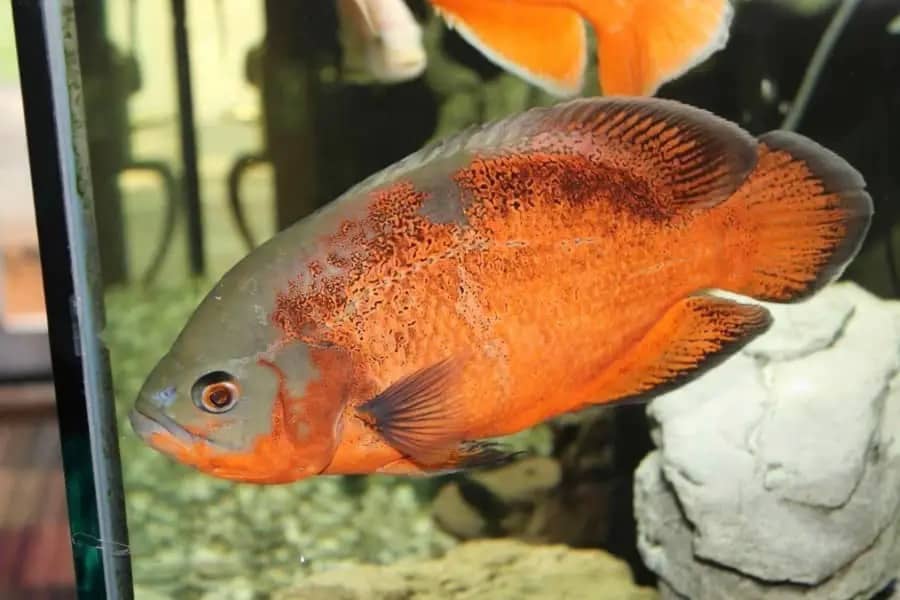
Oscar fish are prone to several diseases; the most common ones are: Hole in the Head, Fin and Tail Rot, Ich, Popeye, and Bloat.
By understanding the symptoms and causes of these diseases, Oscar fish owners can promptly identify and address any potential issues.
Let’s explore each of these in detail:
Hole in the Head (HITH) Disease
Hole in the Head disease, also known as HITH, is a common ailment among Oscar fish. While the exact cause of this disease remains unknown, it is believed to be caused by a flagellate parasite called Hexamita, along with other reasons.
In normal circumstances, the parasite lives harmlessly in fish intestines, kept under control by the immune system and internal processes of the fish.

In fish with weak immune systems, the parasite can multiply and spread to other organs, causing complications.
Oscar fish or other fish in general with this disease appear to have small craters on their heads or flanks.
Causes:
- Hexamita parasite
- Overcrowding
- Vitamin or mineral imbalances
- Improper Nutrition
- Poor water quality
Symptoms:
- White sores around the eyes and on top of the head
- Pitting lesions of the head and lateral line
- Larger holes and sores
- Loss of appetite
- Lethargy
- Frayed fins
- Dull coloration
- Emaciated or weakened appearance
Treatment:
For treating this disease, Medications like Flagyl (metronidazole) can be added to the aquarium water, and the fish can be bathed in it for about 24 hours, or if the fish is willing to eat, then this medication can also be administered through medicated fish food flakes.
Moreover, since environmental factors may influence the condition, it is essential to focus on correcting any husbandry issues that may contribute to the disease.
Maintaining optimal water quality, providing a balanced diet, and ensuring proper nutrition are essential.
Fin and Tail Rot
Fin and Tail Rot is a bacterial infection commonly caused by Aeromonas, Pseudomonas, Vibrio. It is commonly observed in fish from pet stores as they are usually kept in poor water conditions.
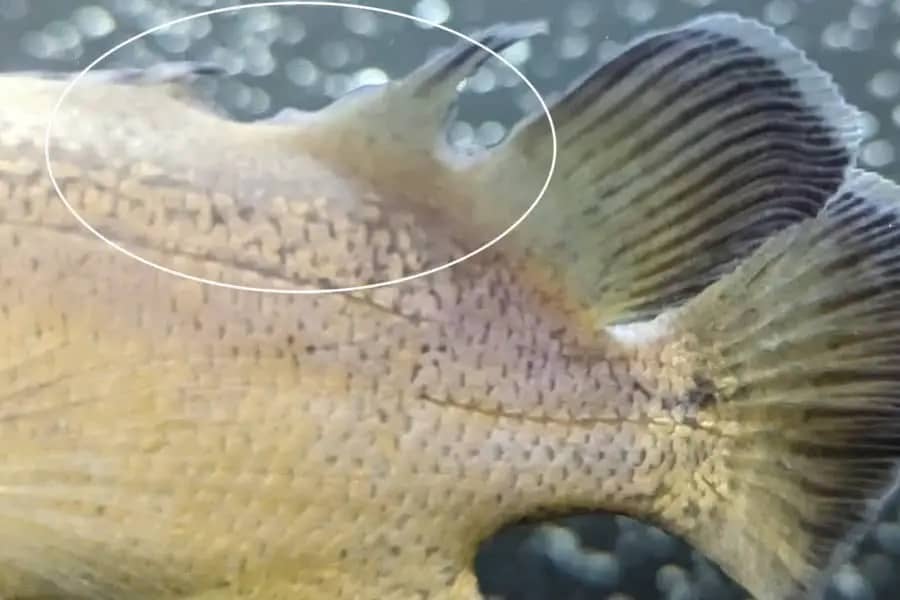
Similar to Hole in the Head disease, fin and tail rot is more prevalent when fish are stressed by poor environmental conditions such as poor water quality and overcrowding.
Causes:
- Bacterial Infection
- Overcrowding
- Wounds (As it creates an entry point for bacteria)
- Poor water quality
- Immune System Weakness
Symptoms:
- Tattered, bloody, or blackened fins
- Decreased appetite
- Fins showing signs of decay or falling off altogether.
- Listlessness
- Increased surface dwelling
- A slimy or milky appearance to the fins or body
Treatment:
In most cases, fin and tail rot is treated with antibiotics. Chloramphenicol and tetracycline are two over-the-counter antibiotics that can be effective against bacterial infections. In severe cases, surgery may be required to remove the infected tissue.
Additionally, a water change and the addition of aquarium salt are recommended to create a healthier environment for the affected fish.
Note: Aquarium salt may kill the plants in the aquarium, so it is not recommended to use salt directly in the planted tanks. You can use a separate hospital tank to treat the disease.
Ich (White Spot Disease)
Ich, also known as White Spot Disease, is a common ailment affecting many aquarium fish, including the Oscars.
Ich disease is highly contagious and has a rapid reproduction rate, allowing it to quickly multiply in the aquarium. The warmer the water temperature, the faster the parasite reproduces, increasing the likelihood of an outbreak.
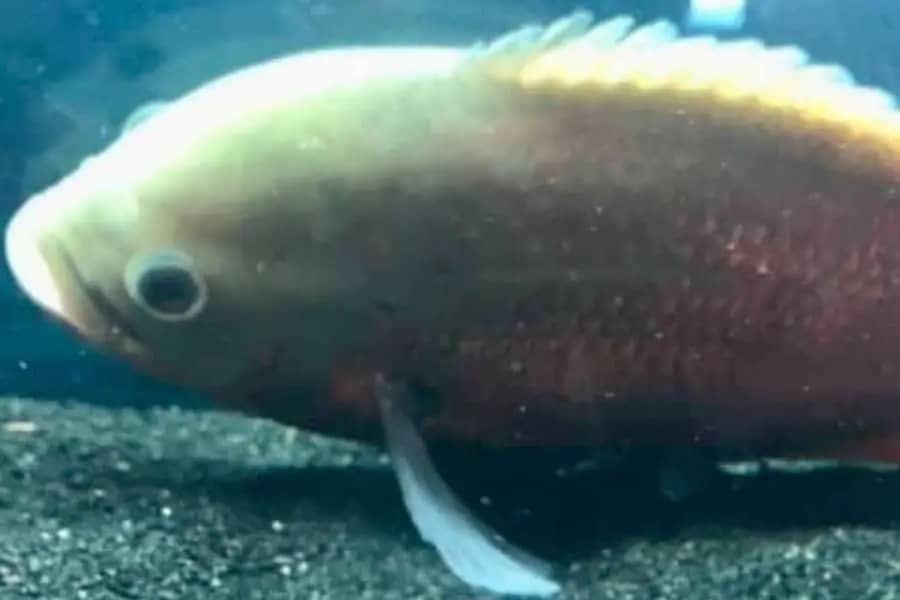
The life cycle of the Ich parasite consists of four stages: trophont, tomont, Tomite and theront.
The trophont stage is the most visible and destructive phase. During this stage, the parasite attaches itself to the fish’s skin or gills and forms small white spots or cysts, giving the disease its common name.
Causes:
- Ichthyophthirius multifiliis
- Weakened Immune System
- Introduction of New Live Plant, Food, and Fish (Parasite can be present in them)
- Poor Water Conditions
Symptoms:
- Loss of appetite
- Reddening of the fins
- White spots on the skin or gills
- Lethargy
- Sitting on the bottom of the tank
- Increased gill movements
- Abnormal hiding behavior
- Rubbing against the environment
- Difficulty breathing
Treatment:
Prompt treatment is essential for Ich to prevent further complications. First, quarantine the infected fish in a separate treatment tank to prevent the disease from spreading to other fish.
Adding aquarium salt to the tank can aid in increasing water oxygenation and encouraging the parasites to detach from the fish. But, it is not recommended to use aquarium salt in the planted tanks, it may harm your plants.
Additionally, there are various medications available for treating Ich, such as Hikari ICH-X, API White Spot Cure, copper sulfate, and formalin.
Lastly, increasing the water temperature within the recommended range of 75-80 degrees Fahrenheit can expedite the treatment process.
Popeye Disease
Popeye, also known as exophthalmia, is not technically a disease but rather a condition that affects Oscar fish and is characterized by the bulging of the eyes.
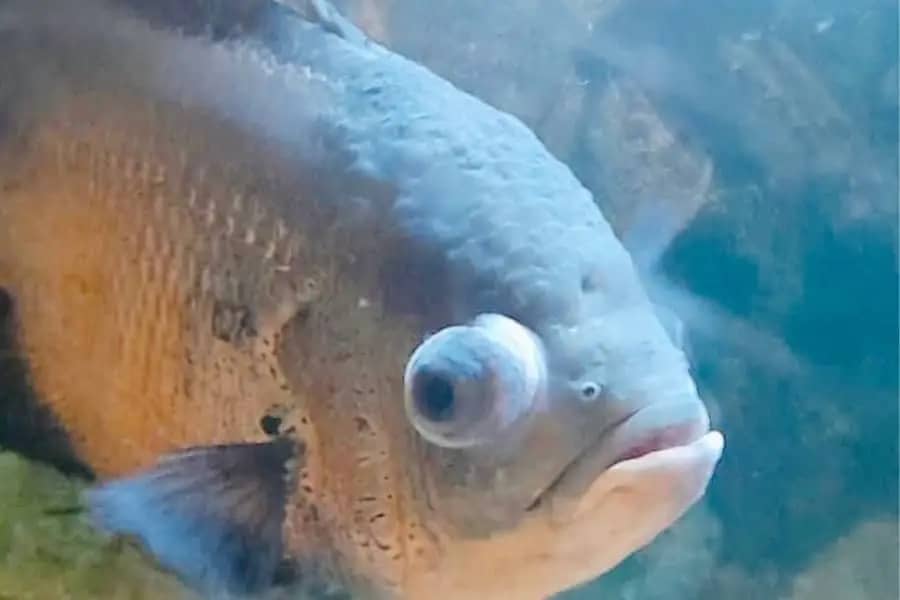
It is primarily caused by chronically poor water conditions as well as the other reasons mentioned below.
The eyes of the fish affected by Popeye may appear swollen, cloudy, or bulging. In some cases, the eye may even protrude from the head of the fish.
Causes:
- Poor water conditions
- Fungi
- Parasites
- Bacteria
- Physical Injuries
Symptoms:
- Swollen or bulging eyes
- Discoloration of fish’s eyeball
- Ruptured eyeball
- Cloudy appearance of the eye
Treatment:
The treatment of Popeye involves addressing the root cause, which is usually poor water quality. Additionally, you can also use antibiotics to combat bacterial infections.
Over-the-counter antibiotic products specifically designed for aquarium such as SeaChem’s KanaPlex can be effective in treating the condition.
The optional addition of aquarium salt to the water can also aid in the healing process.
Note: Don’t add aquarium salt in the planted tank, it can harm your aquarium plants.
Dropsy
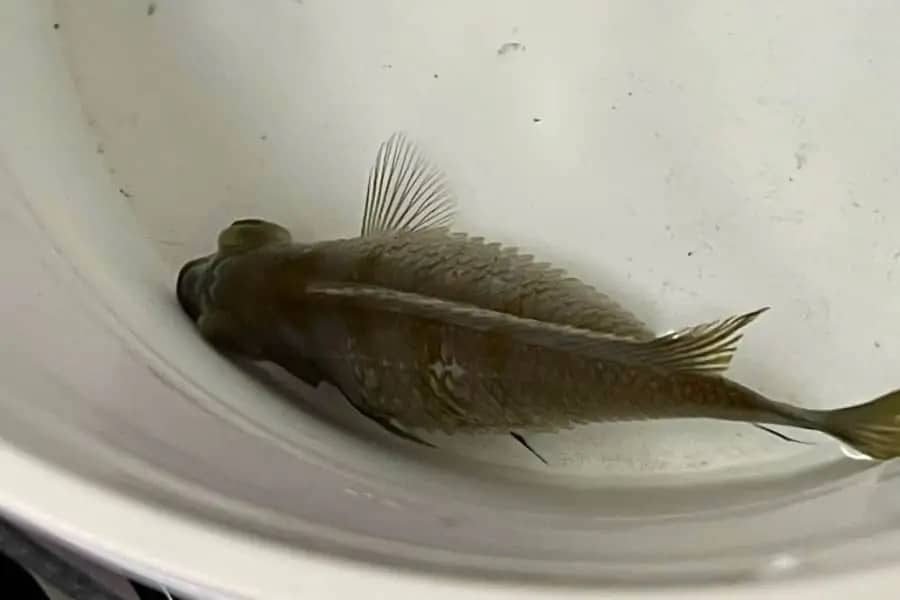
Dropsy is a common health characterized by the abnormal swelling of the fish abdomen or full body and protruding scales. The abdomen or body swelling caused by fluid buildup and protruding scales can be caused by liver dysfunction, kidney failure, or bacterial infection.
Causes:
- Bacterial and Parasitic Infections
- Inadequate Diet
- Organ Damage (Such as the liver and kidney)
- Environmental or genetic Factors
- Poor nutrition
Symptoms:
- Bloated appearance
- Decreased appetite
- A raised appearance to the scales
- Erratic and uncontrolled swimming
- Lack of bowel movements
- Hard feces trailing from the fish
Treatment:
When it comes to treating Dropsy in Oscar fish, the first step is to separate the fish from the main tank and put them in a hospital tank.
After that give them salt bath to remove excess accumulated fluid from the body. The API Aquarium salt is the good option to use for it. However, it is not advised to use aquarium salt in the planted aquarium, because excess aquarium salt can badly damage the aquatic plants.
Thereafter, you can use antibacterial medication to treat dropsy. The recommended medication for dropsy is SeaChem’s KanaPlex (or any other kanamycin-based medication) or Mardel Maracyn II.
If your fish is still eating, you can them offer small pieces of peeled, softened, slightly cooked, or canned peas. These can help alleviate constipation and restore normal bowel movements. Make sure you give them food free from pathogens and chemicals.
dropsy is fatal, in most of the cases its hard to overcome. However, if you notice yearly and treat it quickly then it can be treated.
It is important to note that if the problem persists or if the condition is more severe, at-home treatments may not be sufficient. In such cases, consulting with a veterinarian specializing in fish care is highly recommended.
How to Prevent Oscar Fish from Diseases?

Prevention is always better than cure when it comes to the health of your Oscar fish. By implementing proper care practices and creating a suitable environment, you can significantly reduce the risk of diseases.
Here are some essential tips to prevent diseases in Oscar fish:
1. Maintain a clean aquarium
Regularly clean your aquarium to remove waste, excess food, and debris.
Perform partial water changes at least once a week to maintain optimal water quality. Use a reliable water conditioner to remove chlorine and chloramine from tap water.
2. Monitor water parameters
Test the water regularly to ensure that essential parameters such as temperature, pH, ammonia, nitrite, and nitrate levels are within the appropriate range for Oscar fish.
Sudden fluctuations or imbalances can stress the fish and make them more susceptible to diseases.
3. Avoid overstocking
Do not overcrowd your Oscar fish tank. Overcrowding leads to increased stress levels and poor water quality, making the fish more vulnerable to diseases.
Follow appropriate guidelines for the number of Oscars and other compatible tankmates based on the tank size.
4. Quarantine new fish
Before introducing new fish to your existing aquarium, quarantine them in a separate tank for a few weeks.
This quarantine period allows you to observe the new fish for any signs of illness before they potentially infect the entire tank. It is an effective way to prevent the introduction of diseases.
5. Provide a balanced diet
Feed your Oscar fish a balanced and varied diet to ensure they receive all the necessary nutrients. Include high-quality pellets, flakes, and frozen foods, in their diet.
Avoid overfeeding, as it can lead to digestive problems and subsequent health issues.
6. Maintain proper filtration
Install an efficient filtration system appropriate for the size of your aquarium.
A good filtration system helps remove waste, toxins, and excess nutrients from the water, promoting a healthier environment for the fish. Regularly clean and maintain the filter to ensure its optimal performance.
7. Create hiding spots
Provide ample hiding spots and structures in the aquarium, such as caves, plants, and driftwood. These hiding spots offer the Oscar fish a sense of security and reduce stress. A less stressed fish is less susceptible to diseases.
8. Observe and intervene
Regularly observe your Oscar fish for any unusual behavior, changes in appetite, or physical signs of disease.
Promptly intervene if you notice any signs of illness, such as changes in appearance, changes in swimming patterns, etc. Early detection and treatment can significantly improve the chances of a successful recovery.
Conclusion
So that’s it for this article.
In a nutshell, by being vigilant and attentive to the symptoms of common Oscar fish diseases, you can take prompt action to provide the necessary treatments to improve the health and well-being of your Oscar fish.
You can minimize the risk of diseases by maintaining a clean and well-balanced aquarium, monitoring water parameters, and providing a stress-free environment.
